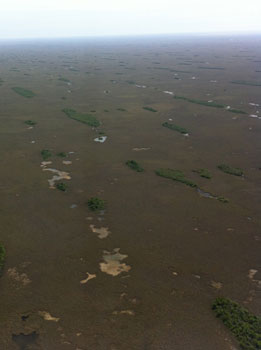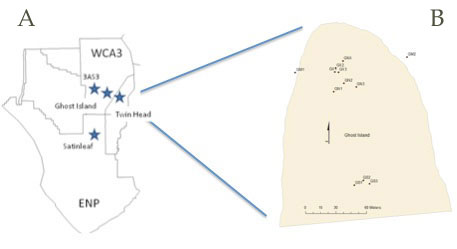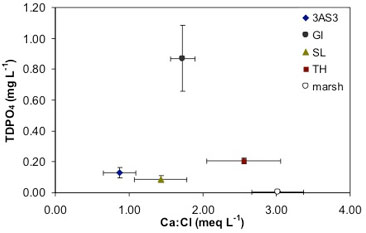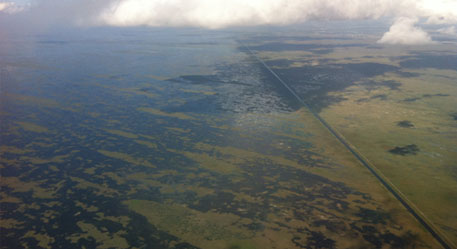Hydrology, phosphorus dynamics and plant-soil interactions in Everglades tree islands

Numerous tree islands, aligned with the historic direction of surface water flow, dot areas of the Everglades landscape.
Background
In the Everglades, tree islands are considered characteristic of the ecological “health” of the landscape. Phosphorus (P) levels in upland tree island soils are >100 times higher than P in adjacent marsh soils. Of primary concern is conservation of tree island habitat and maintaining tree island soil P to prevent P enrichment of local marsh communities.
Research Objectives
Hydraulic and geochemical properties are a key aspect to understanding how the structure and function of tree islands can be maintained and restored. For example, patterns of differential evapotranspiration influenced by the presence of trees in the marsh landscape (indicated by daytime drawdown of the tree island soil water table) and associated concentration of chloride (Cl) ions in soil water (indicating plant-water interactions that build ionic strength and promote mineral soil stability) are being quantified to help further define characteristics of “healthy” tree islands.
In this project, we are relating tree island community structure, hydrology and hydrogeochemical characteristics to refine tree island monitoring and performance measures. Our study couples intensive measurements of hydraulic head gradients and ionic strength in surface and groundwater wells with data on soil phosphorus, stem and source water 18O and 2H isotopic composition and plant nitrogen and carbon isotope patterns on four Everglades tree islands that vary along hydrologic and disturbance gradients.
Study Area
Our work is focused on tree islands in the Water Conservation Areas (WCA) and in Everglades National Park (ENP): wet, intact (3AS3-WCA3A); wet, degraded (Ghost Island-WCA3A); dry, intact (Satin Leaf-ENP); and dry, degraded (Twin Heads-WCA3B) with an experimental design that is stratified by tree island plant communities including upland High Head, wetland forest Wet Head, and low stature wetland forest Near Tail, and adjacent sawgrass marsh.
 The study was designed to characterize hydrogeochemical characteristics of two degraded and two “intact” tree islands one of each pair subject to either drier or wetter conditions as a function of its regional location (i.e. wetter in WCA 3A and drier in WCA3B and ENP; panel A). Nested within each tree island is monitoring within three tree island communities and adjacent marsh and at multiple soil depths (i.e. 30, 60 and 90cm below the soil surface; panel B).
The study was designed to characterize hydrogeochemical characteristics of two degraded and two “intact” tree islands one of each pair subject to either drier or wetter conditions as a function of its regional location (i.e. wetter in WCA 3A and drier in WCA3B and ENP; panel A). Nested within each tree island is monitoring within three tree island communities and adjacent marsh and at multiple soil depths (i.e. 30, 60 and 90cm below the soil surface; panel B).
 Hydrologic barriers not only block advective sheet flow and result in drier conditions downstream of the barrier but also result in “ponding” upstream of the barrier. This “ponding” can produce conditions that are associated with tree island overflooding.
Hydrologic barriers not only block advective sheet flow and result in drier conditions downstream of the barrier but also result in “ponding” upstream of the barrier. This “ponding” can produce conditions that are associated with tree island overflooding.
Despite variation in Calcium:Chloride (Ca:Cl), High Head (HH) soil waters of tree islands except Ghost Island showed elevated TDPO4 relative to marsh soil water, but average values are typically below 0.25 mg L-1 except for the Ghost Island. Ghost Island soil water had average TDPO4 nearly 4 times the average concentration of other islands. Lower potential for mineral precipitation and high TDPO4 suggest that HH soils are less stable and potentially releasing phosphorus. Moreover, the overflooded Ghost Island illustrated the greatest deviation from other islands in Ca:Cl, TDPO4 and calcite saturation index.

Project Collaborators
Carlos Coronado-Molina, Victor Engel, Jennifer Richards, Leo Sternberg, Steve Krupa, Susan Newman, Michael Manna, Rene Price, Paul Wetzel, Fred Sklar
Funding sources
South Florida Water Management District, US Army Engineer Research and Development Center, National Park Service
Contact Tiffany Troxler for more information and recent project reports.

